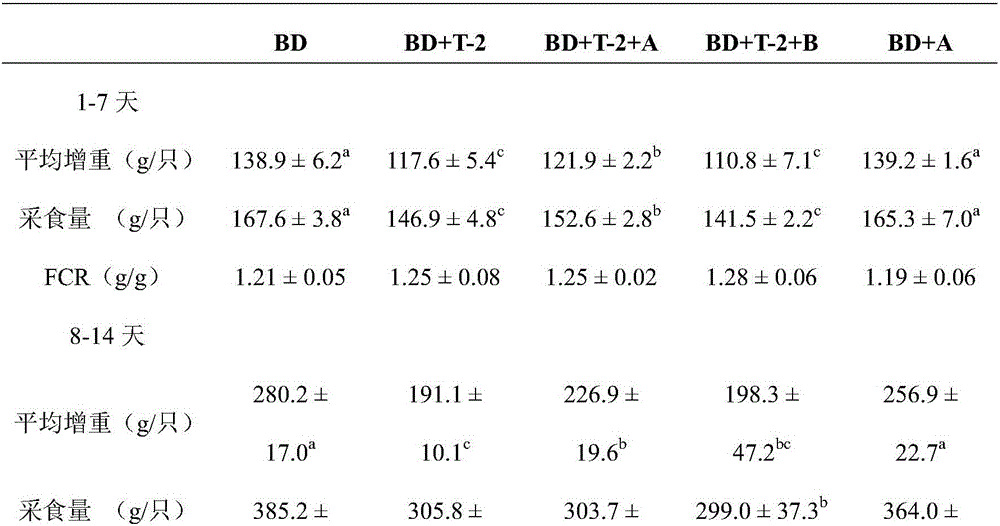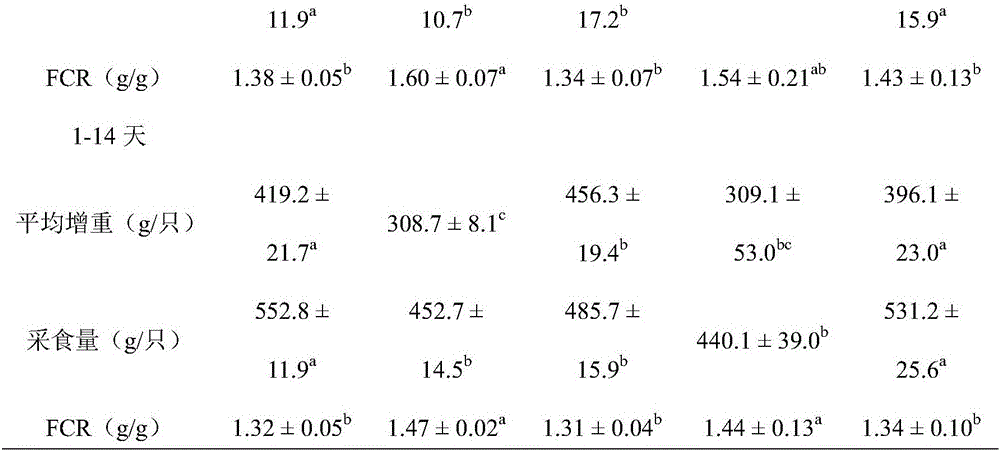Livestock feed T-2 toxin compound adsorbent as well as preparation method and application thereof
A composite adsorption, livestock and poultry feed technology, applied in the field of livestock and poultry feed T-2 toxin composite adsorbent and its preparation, can solve the problems of ignoring the health protection effect of additives on the body, lack of animal nutrition, adsorption effect of mycotoxin adsorbent and clinical Difficult application effects and other problems, to achieve the effects of improving growth performance, promoting body health, and alleviating toxic effects
- Summary
- Abstract
- Description
- Claims
- Application Information
AI Technical Summary
Problems solved by technology
Method used
Image
Examples
preparation example Construction
[0021] The preparation method of the above-mentioned livestock and poultry feed T-2 toxin composite adsorbent comprises the following steps:
[0022] 1) The modified activated carbon is obtained by placing the powdered activated carbon at a temperature of 1000-1200° C. for 3-5 hours in an oxygen barrier heat treatment; the mesopore volume of the modified activated carbon is 0.570-0.685 cm 3 / g, the specific surface area is 1030~1078m 2 / g;
[0023] 2) Weigh the modified montmorillonite, selenomethionine hydroxyl analog, yeast cell wall polysaccharide, modified activated carbon and curcumin according to the above weight percentage, and set aside;
[0024] 3) uniformly mixing the modified montmorillonite, selenomethionine hydroxyl analog, yeast cell wall polysaccharide, modified activated carbon and curcumin; obtaining the T-2 toxin composite adsorbent for livestock and poultry feed.
[0025] Sources of the above raw materials:
[0026] The preparation method of modified mont...
Embodiment 1
[0055] The preparation method of the above-mentioned livestock and poultry feed T-2 toxin composite adsorbent 1 comprises the following steps:
[0056] 1) Put the powdered activated carbon at 1100°C for 4 hours to obtain modified activated carbon; the mesopore volume of the modified activated carbon is 0.570-0.685 cm 3 / g, the specific surface area is 1030~1078m 2 / g;
[0057] 2) Weighing 62.0% of modified montmorillonite, 1.0% of selenomethionine, 20% of yeast cell wall polysaccharide, 15% of modified activated carbon and 2.0% of curcumin according to the above weight percentage, and set aside;
[0058] 3) Mix the modified montmorillonite, selenomethionine hydroxyl analog, yeast cell wall polysaccharide, modified activated carbon and curcumin evenly; obtain T-2 toxin composite adsorbent 1 for livestock and poultry feed.
Embodiment 2
[0060] The method for preparing livestock and poultry feed T-2 toxin composite adsorbent 2 in this embodiment is basically the same as that in the embodiment, except that:
[0061] The raw material of livestock and poultry feed T-2 toxin composite adsorbent 2 consists of 65% modified montmorillonite, 1.0% selenomethionine hydroxyl analog, 21% yeast cell wall polysaccharide, and 10% modified activated carbon according to weight percentage. And 3.0% curcumin composition.
PUM
| Property | Measurement | Unit |
|---|---|---|
| Mesopore volume | aaaaa | aaaaa |
| Specific surface area | aaaaa | aaaaa |
Abstract
Description
Claims
Application Information
 Login to View More
Login to View More - R&D
- Intellectual Property
- Life Sciences
- Materials
- Tech Scout
- Unparalleled Data Quality
- Higher Quality Content
- 60% Fewer Hallucinations
Browse by: Latest US Patents, China's latest patents, Technical Efficacy Thesaurus, Application Domain, Technology Topic, Popular Technical Reports.
© 2025 PatSnap. All rights reserved.Legal|Privacy policy|Modern Slavery Act Transparency Statement|Sitemap|About US| Contact US: help@patsnap.com



